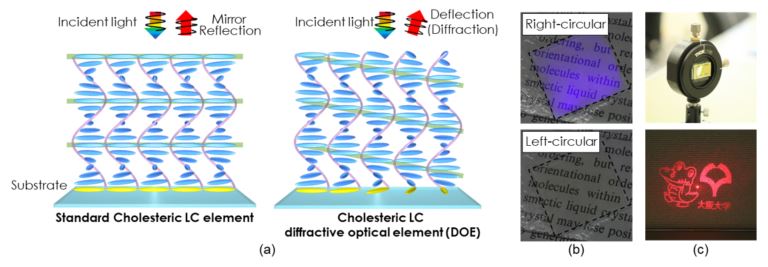Coating-producible volume diffractive optical elements (DOE) based on liquid crystal polymers
January 4, 2021
Cholesteric liquid crystals can be used as volume diffractive optical elements by controlling its structural phase.
Key Word : Volume diffractive optical element, holographic optical element, liquid crystal, diffraction, hologram
Background / Context / Abstract:
Conventional optical systems guide light using bulky optical elements such as lenses and mirrors, but the spread of wearable devices is pushing the need for thin optical elements with the capability to control light. Volume diffractive optical elements (DOEs) that control light propagation based on diffraction rather than refraction is one candidate to achieve thin optical elements, but the conventional fabrication method included light interference, which greatly compromised the size of the element that could be fabricated.
We have developed a novel volume diffractive optical element based on a liquid crystal polymer material. The liquid crystal material we employed is called the “cholesteric” or “chiral nematic” liquid crystal and spontaneously forms a helical structure with a pitch that can be controlled from the ultraviolet to the infrared by choosing appropriate materials. The helical structure gives rise to Bragg reflection of light, which has a phase distribution defined by the surface alignment pattern of the liquid crystal. A plane wave impinging on the element is thus Bragg reflected at a certain wavelength and, at the same time, modulated in wavefront, i.e., diffracted. Because the device exploits the self-organizing nature of the cholesteric liquid crystal to form a helical structure, a volume DOE can be fabricated by simply coating the material on an appropriately patterned substrate.
Technology Overview:
Cholesteric liquid crystals are well-known liquid crystal phases and have long been known as self-organizing mirrors because of their ability to form a helical structure with a pitch comparable to the wavelength of visible light. We have demonstrated that cholesteric liquid crystals can be used as volume diffractive optical elements (DOEs), i.e., show non-mirror-like reflection, by controlling its structural phase. Because the helix forms spontaneously, the local alignment of the liquid crystal on a substrate defines the relative phase of the helical structure at that point. A two-dimensional distribution of surface alignment thus creates a two-dimensional distribution of the phase of the helical structure. Theoretical calculations and experiments have verified that the phase of Bragg reflected light (optical phase) varies depending on the phase of the helix (structural phase), and that a full-wave (0-2π radians) modulation is possible by a 0-π modulation of the alignment.
The device fabrication step comprises a step to treat the substrate for patterned alignment, and a step to coat the liquid crystal. Different methods can be employed to achieve patterned alignment such as micro-rubbing, micro-structural alignment, or photo-induced alignment and should be chosen to satisfy the throughput and patterning resolution requirements. Polarization holography combined with photoalignment techniques enable very fine (<1 µm) patterning of the orientation; although interference is employed, fabrication is much easier than the fabrication of standard volume DOEs (often referred to as holographic optical elements, HOEs) because patterning only needs to be performed on a two-dimensional area (on the substrates) instead of a three-dimensional volume. After treating the substrate, a liquid crystal material dissolved in an appropriate solution can be coated on the substrate and polymerized to create a film-type DOE. Typical thickness of the DOE is several to a few 10 µm.
Depending on the alignment distribution, various optical functions can be achieved by the DOE. For example, when the alignment varies in a linear fashion along one direction, the reflected light is deflected to an angle that depends on the patterning pitch. A parabolic alignment distribution leads to light convergence or divergence, and randomizing the pattern leads to diffuse reflection. In the most general case, computer-generated-hologram (CGH) algorithms can be employed to fabricate DOEs that convert an incident plane wave into any desired wavefront. All optical functions are wavelength selective because of the Bragg-reflecting nature of cholesteric liquid crystals. Furthermore, Bragg-reflection is circular-polarization selective, and show only weak high-order reflection bands because of the helical structure. This is advantageous for applications such as augmented reality (AR) because the reflectivity can be enhanced without sacrificing the transmittance of the DOE by controlling the polarization of the projected light. If necessary, several DOEs can be stacked to operate at multiple wavelengths.
Benefits:
・Volume DOEs that usually require light interference techniques can be fabricated by coating.
・Light reflection is circular-polarization sensitive which enables more efficient light usage in applications where light is intentionally projected on the element.
・There is very small high-order reflection which suppresses unwanted light diffraction.
Potential Applications / Potential Markets:
・Volume diffractive optical elements, holographic optical elements, optical deflectors, optical isolators, security elements, see-through signage, and other applications
State of Development / Opportunity / Seeking:
●Opportunity
・Available for exclusive and non-exclusive licensing
・Exclusive/non-exclusive evaluation for defined period (set up for options)
・Collaborative/supportive research
●Seeking
・Licensing
・Development partner
IP Status:
WO2016/194961 (National phase EP, US, Issued: JP)
Figures:
(a) Schematic diagram of a standard cholesteric liquid crystal element acting as a mirror, and the cholesteric liquid crystal diffractive optical element (DOE) fabricated by patterning the alignment on a substrate.
(b) Photograph showing the circularly-polarization-sensitive Bragg reflection phenomenon of a cholesteric liquid crystal. In the top figure, purple color is reflected when the element is observed through a right-circularly polarized filter. In the bottom figure which is observed through a left-circularly polarizing filter, no reflection is observed. This is due to the helical structure of the cholesteric, which in this particular case has a right-handed helix.
(c) Top figure shows a photograph of a cholesteric DOE placed on an optical mount. Bottom figure shows the hologram image generated by illuminating the element with a red laser. The hologram efficiency is highest when illuminated by circularly polarized light matching the helix structure, and lowest for the circular polarization with opposite handedness.
Contact:
![]()
